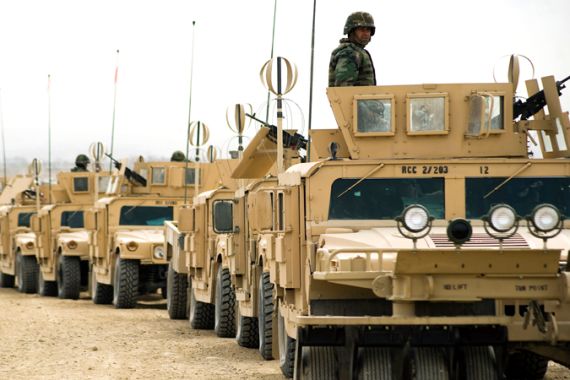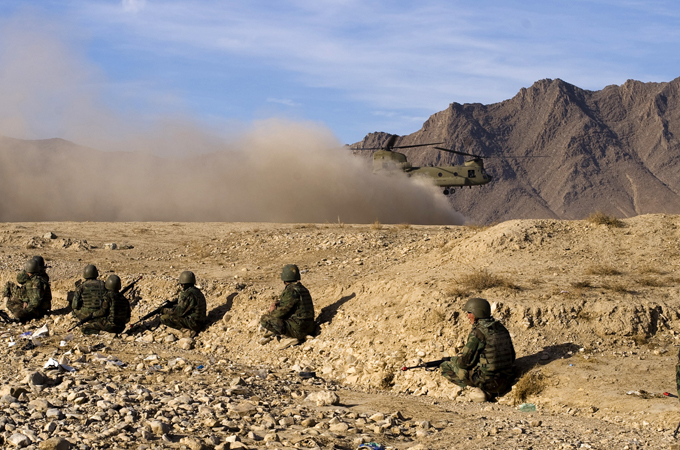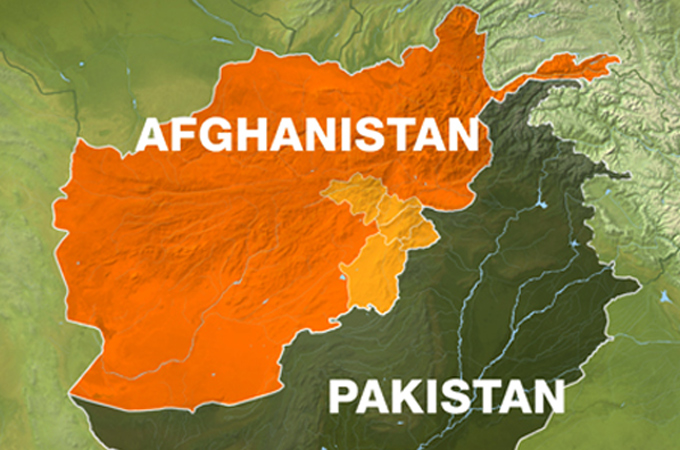Afghan forces target Haqqani strongholds
Focus of conflict shifts east as ISAF-backed Afghan security forces take fight into troubled Pakistani border region.

 |
| NATO says Afghan forces were leading both operations targeting eastern Haqqani strongholds [GALLO/GETTY] |
Afghan and coalition forces have concluded two major operations in eastern Afghanistan against the Taliban and the Haqqani network, signifying the beginning of a shift in military focus towards the troubled border region with Pakistan.
The Afghan-led operations called Knife Edge and Shamshir, which concluded on October 23, lasted 10 days, targeting Haqqani strongholds of Paktya, Paktika and Khost, as well as largely insecure provinces of Ghazni, Wardak and Logar closer to the capital Kabul.
“The operation was aimed at securing key population centers and expanding the Kabul security zone,” Master Sergeant Nicholas Conner, a spokesman for the International Security Assistance Forces (ISAF), told Al Jazeera. Conner was only speaking about operation Shamshir, which falls under his jurisdiction.
About 200 fighters – 20 of them linked to the Haqqani network- “were killed or captured” in both operations, ISAF said in a statement. At least five ISAF soldiers also died.
A spokesman for the Afghan defence ministry refused to comment on the number of Afghan casualties, saying their reports from the field were incomplete.
Extensive clearence operation
The offensive comes after a series of high-profile attacks on Kabul, most of them blamed on the Haqqani network, a faction of the Taliban that allegedly operates out of Pakistan but also holds significant influence in tribal areas on the Afghan side of the border.
As the US-led NATO forces begin handing over security control to Afghan forces ahead of the 2014 withdrawal date, concerns remain about the spread of Taliban and Haqqani influence in the volatile east.
In recent months, Afghan and coalition officials have hinted at shifting military operations to the east, closer to the Pakistani border, to stem the cross-border flow of fighters. Some see the twin operations as the beginning of the kind of extensive clearence operation carried out in southern Helmand and Kandahar province over the past two years.
 |
| Provinces covered in the operation are highlighted |
“The sense is that there is definitely going to be a shift in fighting towards the east,” Conner said. “The east is probably going to be one of the last areas to transition control of security to the Afghan forces – just because of the nature of the fight there.”
In addition to thousands of Afghan army and police forces, “three brigade-size” groups of coaltion forces took part in operation Shamshir, totalling about 10,000 troops, Conner said. Each brigade has 3,500 to 3,800 soldiers.
“Because of the terrain and environment, you are not seeing huge scale operations, but a collection of smaller ones. That’s what Shamshir was: a collection of smaller, company-size operations.”
General Hadi Khaled, a security analyst and former deputy minister of interior, said the operation was a good start, but much more was needed.
“I think this is the beginning of the process. These brief targeted operations are important, but we need extensive clearance operations such as the one in the south – in Helmand and Kandahar – to actually bring security to the eastern region.
“The enemy – particularly Haqqani – has spread far in the larger Paktya area and the east in general.”
Border deployments?
Conner brushed aside media reports that in recent weeks NATO forces were “massing” along Afghanistan’s border with Pakistan.
“That is just a misconception,” he said, arguing that the brigades mobilised as part of Shamshir operation were probably perceived as being deployed to the border.
“In the past four months, troops in border regions such as Paktya and Khost have remained the same,” he said. “In fact, one of the task forces left and the new unit had about 800 soldiers less.”
Regional Command East, as ISAF refers to the eastern military zone, includes such strategic border province as Khost, Kunar, Nangarhar, Nuristan, Paktika and Paktya.
|
“I believe the people are on the side of the government. But the government has been very negligent in providing them security.“ – General Hadi Khaled |
In addition to 33,000 coalition forces, 68,000 Afghan national security forces are also deployed in the zone, with a particular focus on population centres.
However, authorities in Nuristan and Kunar have long complained about a lack of assistance from coalition forces and the Afghan army despite repeated requests.
The mountainous province of Nuristan, in particular, has been constantly under attack in the past couple years, with the Barg-e-Matal district repeatedly falling to the Taliban.
“We neither have international forces here, nor the national army,” Shams ul Rahman Nuristani, the provincial police chief, told Al Jazeera.
“The national army finally sent some soldiers, but they are temporary and will be leaving soon.”
‘Rugged and independent’
He said his staff of 2,800 police, forced to fight in the frontlines, was not enough to secure the province. An additional 500 Afghan Local Police – a militia-like new force- was approved for the Barg-e-Matal and Kamdesh, the two districts taking most of the fire, but their weapons and salaries were yet to arrive.
“The enemy has more presence here than any other province: there are Punjabis, Arabs, Chechens … insurgents of every kind here.”
Sergeant Conner said it was unlikely that Nuristan would be part of the “focus to the east” because of the rugged terrain, and the fact that it was not one of the major “population centres”.
“Our focus in the east is to secure key population centres and expand the Kabul security zone,” he said.
“Nuristan is not a key population centre. And also, the people there are rugged and independent who would probably prefer to be left alone.”
He said ISAF was focused on empowering the Afghan forces in the area rather than deploying its own troops in the secluded province.
Acknowledging the difficulty of the terrain and the infancy of the Afghan air force, analyst Khaled, however, said Nuristan and Kunar were important in achieving any lasting security in the east.
“Nuristan and Kunar are very strategic areas, crucial to reaching the northeast of the country.
“Despite the large presence of the enemy there, I believe the people are on the side of the government. But the government has been very negligent in providing them security.”
Follow Mujib Mashal on Twitter: @mujmash